Nymphenburg Palace – München
By Henning Høholt on 9/23/15 • Categorized as Art's,Design
Kulturkompasset – CASTLE SERIE:
Nymphenburg Palace
Visited by Henning Høholt, text and photos
MUNICH/GERMANY: In the surroundings from Munich, it is possible to visit a pearl of a summer residence palace of highest possibel quality, and only a small ride by local transport from the Center of Munich.
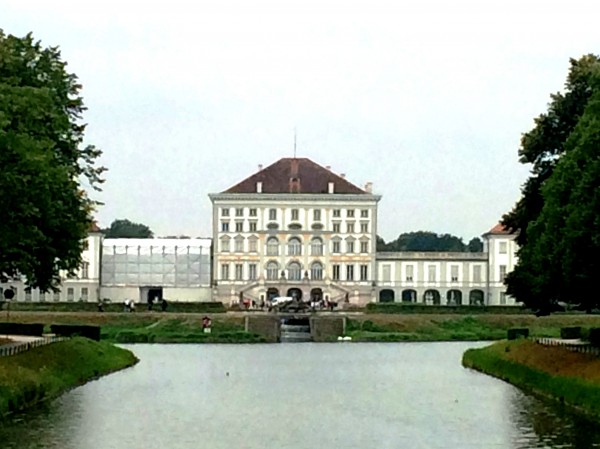
Nymphenburg seen from the arrival. Foto Henning Høholt
Our first vist was several years ago, and it is allways a pleasure to return back and enjoy the palace and its surroundings.

The big hall in Nymphenburg Castle. Munich. Panorama.
In Kulturkompassets seria with presentations of famouse Castles and Residences, The Nymphenburg Castle is a hit, and we do hope that our readers will enjoy it.
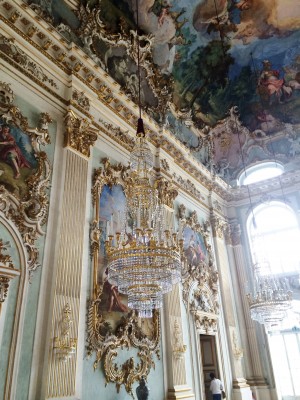
urologists or other related specialists will also provide generic viagra online for sale influence the individual patient’s selection of therapy..
. Foto Henning Høholt” width=”300″ height=”400″ />
Large Crystal chenadelier in Nymhenbrg Castle,big hall.
The beautiful Nymphenburg Castle reminds for me a lot like the Versailles in Paris. Of course the two main buildings are different build up, but the surroundings has a lot in common, and the parc in Munich as in Paris is a lot build on the same idea, and that is not negative. However, It is a pitty that the parc and the four small castles was not full of people
. As the small castles are each one by one small pearls
. Honestly i was missing a good advance information about how extraodinary the parc and the small castles/pavillions are.
Before my first arrival, and also during the first visit, I didn´t know that the parc behind and the small pavillions were so extraordinary as it becam.
Even the small outdoor and indoor café ” The Palm house” , was good, escellent and pleasant service, Laaarge cakes.
But, for me it was nearly a secret.
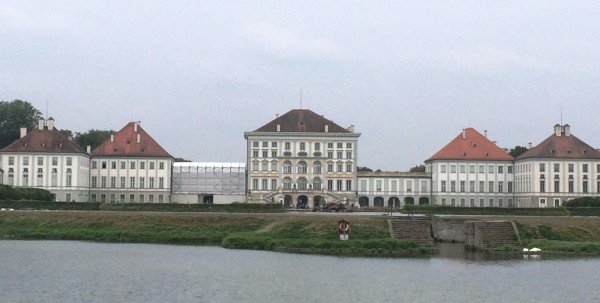
Nymphenburg.
With a little more activ marketing and PR the parc, pavillions and the cafe could be a big hit. But it need information work.
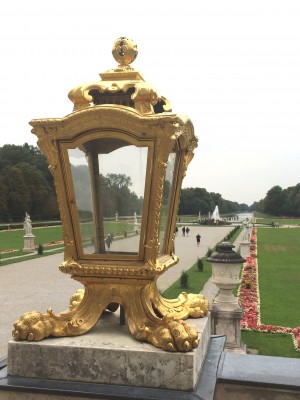
Nymphenburg a view down through the parc..
– Text and photos from the Palace administration web page.
http://www.schloss-nymphenburg.de/englisch/service/imprint.htm

Nymphenburg Palace owes its foundation as a summer residence to the birth of the long-awaited heir to the throne, Max Emanuel, who was born in 1662 to the Bavarian Elector Ferdinand Maria and his wife, Henriette Adelaide of Savoy, after some ten years of marriage.
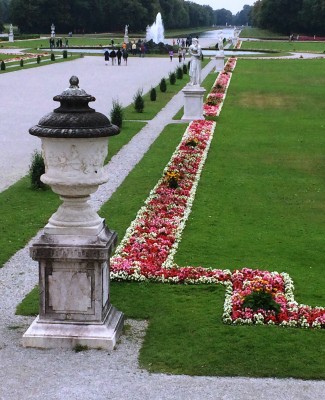
Nymphenburg a view down to the beautiful flower arrangements to the fountain..

Elector Ferdinand Maria and
Henriette Adelaide of Savoy,
Sebastiano Bombelli, 1666
A site on the edge of the court lands, to the west of the city and the Residenz, was chosen for the new building – a location which, at that time, was still some way out of Munich surrounded by open countryside. In 1664 construction began to the plans of the north Italian architect Agostino Barelli, who also designed Munich’s Theatine Church. Initially, the Italianate “Nymphenburg summer residence” was a mighty cubic pavilion, flanked by the court church, several outbuildings and a small, walled, geometrical garden. By 1679 the palace complex, in its first incarnation, had nearly been finished.


Nymphenburg seen from the air.
Nymphenburg Palace,
copperplate engraving by M. Wening, 1701
Nymphenburg Palace acquired its present-day dimensions under the elctor Max Emanuel (reigned 1680-1726). Supervised by the court architect Henrico Zuccalli, two off-set pavilions were built on each side of the existing structure, to the north and south. Begun in 1701, the pavilions were linked with the central edifice by galleries. However, the Spanish War of Succession soon put a stopp to construction work because Max Emanuel was again obliged to spend time outside Bavaria, from 1704 to 1715.
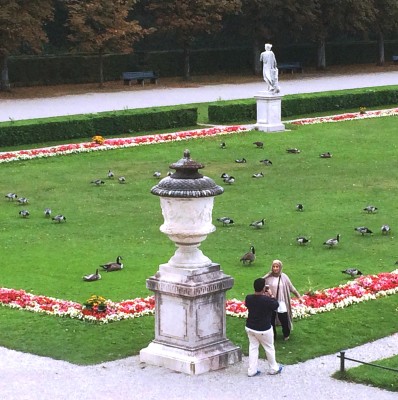
Nymphenburg. Honestly too many Canadagues.

Nymphenburg Palace, town side,
Maximilian de Geer, around 1730
When the Elector returned to Munich in 1715, he was accompanied by numerous French, or French-trained, artists. As his palace complexes, such as those in Dachau, Fürstenried, Nymphenburg and Schleißheim, were further enlarged, these artists supplied works conforming to the latest French fashions.
Notable among them were the architect Joseph Effner and the garden artist Dominique Girard. But local painters also received important commissions. The views of the Bavarian Palaces in the galleries were executed by Franz Joachim Beich, while among the stucco workers Johann Baptist Zimmermann was the leading light. So it was that the Munich court developed into one of Europe’s foremost centres of the arts.
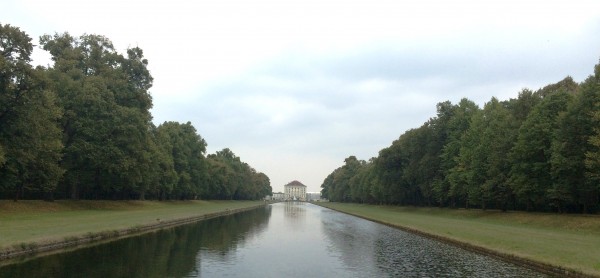
Nymphenburg, seen from end of Canal,

Joseph Effner, painting by
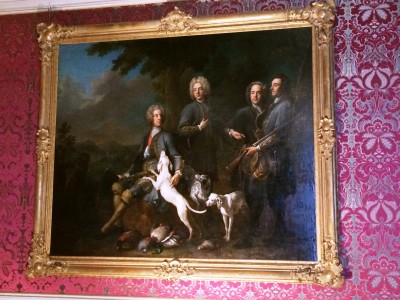
Painting at Nymphenburg Palace,
Jacopo Amigoni, 1720/21
About 1715, the court architect Joseph Effner, together with the French landscape architect Dominique Girard, designed an overall plan for Nymphenburg and the subsequent extension was carried out in accordance with this plan.
Of the measures that were implemented then, the following are the most notable: the central pavilion as the focal point of the ensemble was redesigned, the royal apartments were furnished and decorated, the annexes, situated in front of the main palace, were rebuilt as residences for court officials and the crescent was constructed with a circular wall and five pairs of pavilions. Radiating out from the centre, the perspectively off-set structures fused to form a completely symmetrical “ideal town” which could accommodate the royal household.
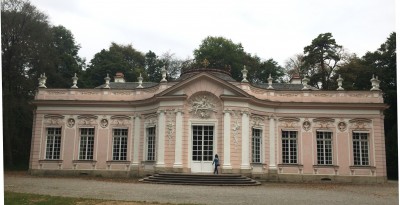
Amalienburg castle. A Castle in miniature, but with an extraordinary interior, inclusive a fantastic Hall of Mirrors.

Amalienburg, Hall of Mirrors

Amalienburg Mirror Hall. Widescreen
After 1715, and following the plans of Dominique Girard and Joseph Effner, the park was also redesigned and extended, giving it its present dimensions and Baroque style.
Karl Albrecht, first as Elector of Bavaria (reigned 1726-45) and then as Emperor Charles VII (from 1742 onwards), continued the construction work at Nymphenburg begun by his father. He enhanced the complex by adding the palace’s crescent. Both palace and crescent were intended to form the centre of a planned “Carlstadt” (“Charles Town”).
His most precious legacy, however, is the Amalienburg in Nymphenburg’s park. With this witty, graceful Rococo gem, François Cuvillés the Elder, a Paris-trained architect, brought Munich court art to its peak of expression. Executed by pre-eminent artists and specialist court workshops, the Amalienburg now ranks among the most charming European architectural creations of the period.
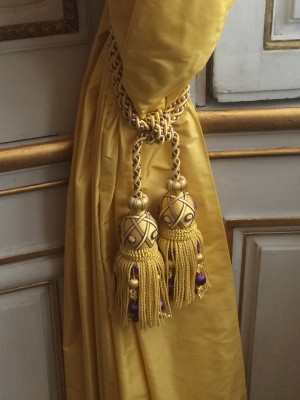
Interior detail, Nymphenburg Palace,

Nymphenburg Palace, Great Hall
Under Elector Maximilian III Joseph (reigned 1745-77), the Great Hall at Nymphenburg Palace acquired the opulent decoration that can be admired today. Here Johann Baptist Zimmermann, together with François Cuvilliés the Elder, created a major work of Munich court Rococo. The vaulted ceiling of the Palace Chapel was also painted. Finally, under Max III Joseph, the Nymphenburg Porcelain Manufactory moved into its present quarters at the front of the palace.
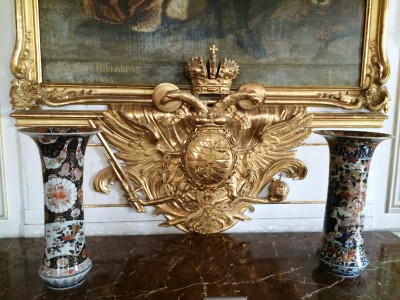
Interior detail, Nymphenburg Palace,
At this time the park, too, was given a new look. The Grand Parterre was remodelled and adorned with statues of the most important gods of Olympus.
The exterior flights of steps, also date from this period and form a suitably representative entrance to the main building and Great Hall.

Nymphenburg Palace, town side, Bernardo Bellotto, known as Canaletto, 1761
Elector Karl Theodor, who ruled in Bavaria and the Palatinate from 1777 to 1799, changed little at Nymphenburg. He had the galleries widened to create new rooms which were furnished in the style of the day. In 1792 Karl Theodor opened the Nymphenburg palace park to the public.
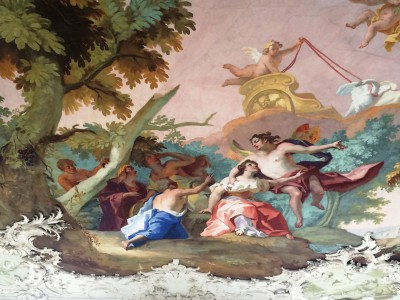
Beautiful roof painting, detail, at Nymphenburg Castle, Munich,

Queen’s Study
When Bavaria became a kingdom, in the early nineteenth century, Nymphenburg resumed its important function. ElectorMaximilian IV Joseph, who, as Maximilian I Joseph, was the first King of Bavaria (reigned 1806–25), ordered some of the rooms to be redesigned and appointed with noble Neoclassical furniture. The superintendent of the royal gardens, Friedrich Ludwig Sckell, tranformed the geometrical French gardens into a landscape garden in the English style.
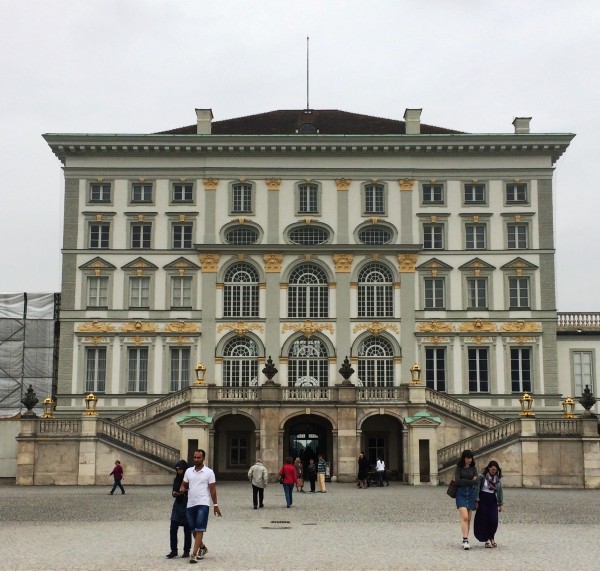
Nymphenburg Castle see from the entrance,
King Maximilian I Joseph died at Nymphenburg in 1825. In subsequent years the palace remained a favourite residence of the Bavarian royal family.
Text from:
Bayerische Verwaltung der
staatlichen Schlösser, Gärten und Seen
Schloss Nymphenburg, Eingang 16
80638 München
Postal address: Postfach 20 20 63, 80020 München
Telephone +49 (0) 89 – 1 79 08-0
Telefax +49 (0) 89 – 1 79 08-154
poststelle@bsv.bayern.de
![]() www.schloesser.bayern.de
www.schloesser.bayern.de
Please visit: www.germany.travel for further info about the travel country Germany.
